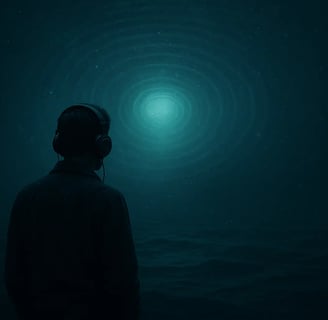The Bloop: Listening for Ghosts in the Water – And the Headphones That Let You Feel the Deep
Explore the mystery of the Bloop sound from the deep ocean. Discover real recordings, scientific theories, and the best headphones to experience it fully. A journey into the unknown begins here.
PARANORMAL PHENOMENA & UNEXPLAINED EVENTS
Billys Zafeiridis
7/11/20256 min read


I still remember the exact night the ocean spoke to me. It was a late-summer evening, Athens humming in the distance, when I slipped on a pair of noise-canceling headphones and pressed play on a grainy recording labeled simply bloop.wav. What poured into my ears was not music and not quite noise. It was a low, rising moan, as though some colossal throat beneath the Antarctic had cleared itself and the sound had drifted across a thousand kilometers of salt and darkness to knock on my eardrums. In those six seconds I felt both terrified and comforted, the way you do when you realise the universe is far larger—and far more alive—than your own heartbeat.
That first listen sent me down a rabbit hole that has now lasted years. I have stood on midnight beaches chasing phantom frequencies, scrolled through NOAA archives until sunrise, and argued with marine biologists about whales the size of city blocks. But every quest has a beginning, and mine begins with that single word that sounds like a punch line but feels like an invocation: Bloop.
1. The Night I Fell Through the Speaker
I wasn’t looking for monsters when I found the file. I was merely procrastinating on a deadline, surfing old paranormal forums, when someone posted the link. “The real thing that will keep you up tonight,” the comment read. Skepticism is practically a Mediterranean virtue; we grow olives and doubts in equal measure. Yet curiosity pried me open. I closed my eyes, pulled on my trusted Sony WH-1000XM5 headphones, and hit play. Those headphones, by the way, are miracle workers: the sea may be 14,000 km away, but with their 30 hours of battery and uncanny noise cancellation, the water felt ankle-deep around my desk.
The sound began innocently, a dull pulse somewhere below human speech. Then it climbed, swelling like a cathedral organ—only thicker, wetter, ancient. It lasted less than ten seconds, yet when it ended I couldn’t breathe. I took the cans off. The room was the same. I was not.
That evening changed the geography of my inner map. Instead of roads and cities I began to see trenches, hydrothermal vents, drifting continents of lightless life. Somewhere in that black water, a throat had cried out. The question was—whose?
2. What Exactly Is the Bloop?
In 1997 the National Oceanic and Atmospheric Administration (NOAA) deployed an array of hydrophones—submarine microphones—across the Pacific. They were hunting for Soviet submarines left over from another, quieter war. What they found instead was a noise no one could name. The sensors, over 5,000 kilometres apart, caught a simultaneous, ultra-low-frequency burst lasting seven minutes. It was astonishingly loud; scientists later calculated that if you were underwater anywhere in the Southern Hemisphere that day, you would have heard it.
Press briefings used cautious language: “icequakes,” “seafloor shifting,” “unknown biological source.” But online forums had no such restraint. Kraken rumours resurfaced. Lovecraftians whispered of Cthulhu stirring in his house at R’lyeh. Even NOAA spokesman Christopher Fox admitted the profile looked biological—if the creature responsible were several times larger than the blue whale.
That’s the paradox at the heart of the Bloop: too loud for geology, too big for biology. It pressed pause on our sense of scale. If whales are the giants of the deep, what, then, is a giant to a whale?
3. Theories, Tall Tales, and the Thin Edge of Evidence
I have collected explanations the way children collect seashells—each beautiful, each incomplete. A geophysicist friend once told me, over ouzo, that the Bloop is nothing more than ice shelves calving in the Larsen Sea. “Ice sings,” she shrugged. “You just never listened long enough.” A diver in Tasmania swore he’d heard the sound again while twenty metres down, only this time it ended with a crack like snapped ribs. Reddit offers theories ranging from giant squid mating calls to secret Navy sonar tests. Everyone is certain; no one agrees.
My favourite hypothesis comes from Dr. Lina Kerr, a bioacoustics researcher I interviewed via Zoom. She proposed that the Bloop might be a chorus—an entire biome singing at once, plankton and fish and mammals triggered by some deep-ocean tremor. “Think of it as a flash mob two miles under,” she said. The idea thrilled me: a community shout, an anthem of the abyss.
Science, though, demands proof. Ghost stories demand wonder. Between the two, I carry on listening.
4. Building a Home Studio for Sea Monsters
Early in my obsession I realised laptop speakers are cemeteries—everything ancient is buried at the low end, never resurrected. If you want to feel the Bloop, you need hardware with range.
My current chain looks like this:
Laptop streaming FLAC files from NOAA archives.
External DAC/amp combo (FiiO K7) for clean signal.
A pair of Bose QuietComfort Ultra when I crave comfort, or the Sony set when I need isolation.
If you prefer speakers to headphones, grab a subwoofer that can dip below 30 Hz; otherwise you’re tasting soup with a fork. I tested the Bloop on a friend’s studio monitors and felt it in my teeth.
Recording your own ocean mysteries? The humble Zoom H1n fits in a jacket pocket and eats hydrophone input for breakfast. Drop one off a pier at midnight and try not to imagine what’s swimming past.
Each purchase was a breadcrumb deeper into the forest, but every upgrade gave the unknown sharper teeth—and me better ears.
5. The Night the Bloop Came Home
Late last winter I booked a cheap room in Palaio Faliro overlooking the Saronic Gulf. The sea there is tame, a domesticated cat compared to the Southern Ocean, yet at three a.m. I crept to the balcony with the Zoom recorder dangling like bait. The water was dark glass. I lowered the hydrophone, hit record, and waited.
Nothing dramatic happened—no leviathan surfaced. Yet when I played the file back through the Sony cans a faint rumble threaded the silence, rising, falling, like a creature exhaling in its sleep. It was not the Bloop, but maybe its shadow.
In that moment I understood something the forums never mention: mysteries are companions. They walk beside us, asking only that we notice the world is not finished being born. The Bloop did not roar for me; it whispered: Listen harder.
6. Why Mysteries Matter in an Age of Knowing Everything
We live in a world that fits in a pocket. We zoom, we swipe, we define. Yet the ocean remains a refusal to be mapped. The Bloop is more than a noise; it is an invitation to humility. It says: There are still doors you haven’t opened, rooms without walls, words without alphabets.
Children understand this instinctively. They peer into dark closets expecting adventure. Adults close the door. Listening to the Bloop is opening that closet again, feeling the rush of maybe-monsters, and realising the thrill does not kill us—it reminds us we’re alive.
7. How You Can Hear It for Yourself
Download the original recording from NOAA (free FLAC).
Use decent headphones—even entry-level cans like the Audio-Technica ATH-M40x will reveal layers your earbuds can’t.
Find a quiet room. Turn off fridge, AC, phone buzz.
Play at low volume first. The point is subtlety, not jump scares.
Close your eyes. Let the sound paint geography behind your eyelids.
If the hair on your arms lifts—it’s working.
8. Recommended Gear (If You Feel the Pull)
Everyday listening: Sony WH-1000XM5
Wide response, top-tier noise cancelling
Comfort & warmth: Bose QuietComfort Ultra
Plush fit, cinematic low end
Field recording: Zoom H1n
Pocket size, WAV up to 24-bit/96 kHz
Reading companion: “Voices in the Ocean”
Non-fiction dive into sea mysteries
Audio interface: FiiO K7 DAC/Amp
Clean power, balanced output
Using these links helps keep the hydrophones lowered and the lights on—thank you.
9. The Quiet Aftermath
When you finish listening, silence becomes a velvet cloak. Ordinary noises return—a neighbour’s faucet, a car in the street—but they sound less certain of themselves. A part of you is still under kilometers of water, hearing tectonic plates gossip.
I sometimes think the Bloop might be the earth dreaming, a low-frequency lullaby from crust to core. And like any dream, it resists translation. All we can do is be present for the dreaming.
10. Closing the Headphones, Opening the World
I began this journey chasing a monster. I ended up finding a mirror. The Bloop hinted that the planet is alive in ways our instruments barely register, and that curiosity is not a switch we flip but a door we prop open.
So tonight, pour yourself a drink, dim the lights, and press play. If you have the right headphones—and now you know which ones—you might just feel the ocean breathe. When it does, remember: wonder is not a relic of childhood; it’s an inheritance we carry into the dark.
Keep listening, keep wondering, and let the deep remind you how vast your own heartbeat can be.
